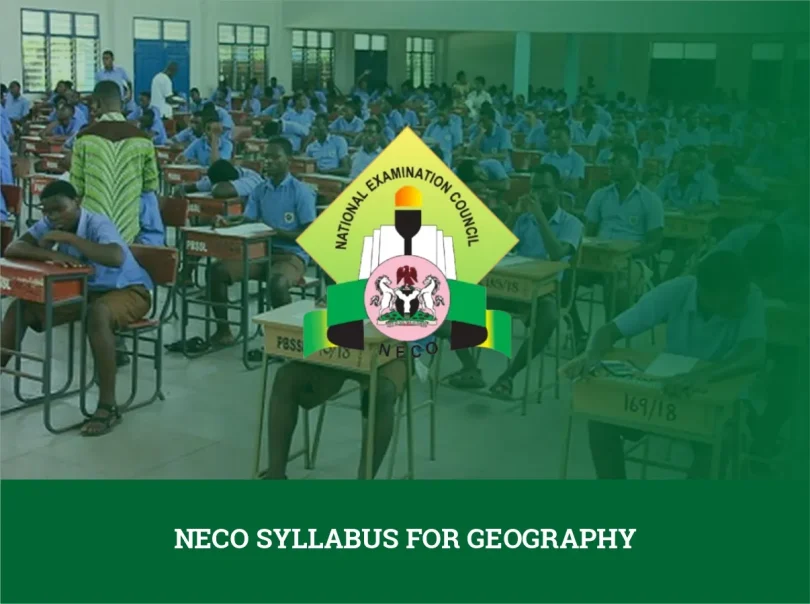If you are preparing for the 2025 NECO Geography examination, having a clear understanding of the NECO Syllabus for Geography is essential. The NECO syllabus tells you exactly what to study, so you don’t waste time on what is not needed. The National Examinations Council (NECO) is a Nigerian government examination body that organizes the Senior School Certificate Examination (SSCE). This exam is taken by students in their final year of secondary school (SS3), and passing it is a key step to gaining admission into universities, polytechnics, or colleges of education.
Geography is the study of the Earth, its landscapes, people, places, weather, and how all these things interact. It helps students understand the physical world and human activities, and how we can manage natural resources and our environment. If you are writing Geography in the 2025 NECO examination, then this article is for you to guide you through as you prepare for the exam. Ensure you read closely to be guided!
Why Is the NECO Syllabus Important?
The NECO Geography syllabus outlines exactly what students are expected to know for the exam. It helps you:
- Focus on the right topics
- Understand the structure of the exam
- Know what skills and knowledge will be tested
- Avoid wasting time on unnecessary content and materials
Studying with the syllabus will surely help you to pass Geography in NECO 2025.
NECO Geography Exam Objectives
The NECO Geography exam is designed to test your:
- Knowledge and understanding of geographic facts and concepts
- Ability to read, draw, and analyze maps and graphs, and conduct fieldwork.
- Ability to relate geography to daily life and current events
- Analytical thinking, interpreting data, comparing regions, and suggesting solutions to problems
- Test knowledge of environmental issues and their impacts.
- Encourage the application of geographical concepts to real-world scenarios
- Ability to use your knowledge to solve problems (e.g., flood control, urban planning)
Exam Structure
The NECO Geography paper is usually divided into three sections:
Paper I – Objective (50 marks): Objective questions covering the entire syllabus.
- 50 multiple-choice questions
- Test your broad understanding
Paper II – Essay (100 marks) Questions cover physical, human, regional, and world geography
- You will answer 4 or 5 structured questions
- You may be asked to draw diagrams, maps, or describe features
Paper III – Practical/Map Work (50 marks)
- You will be given a topographic map or data to interpret
- Expect to draw cross-sections, measure distances, and interpret features
Key Topics in the NECO Syllabus for Geography 2025
1. Physical Geography
- The Solar System: Study of the sun, planets, and their movements.
- The Shape and Structure of the Earth: Understanding Earth’s layers and their characteristics.
- Weather and Climate: Differentiating between weather and climate, and their elements.
- Climate Zones and Vegetation Types: Exploring various climate zones and associated vegetation.
- Rocks and Rock Types: Classification and formation of different rock types.
- Landforms: Study of mountains, plateaus, valleys, and plains.
- Drainage Systems: Rivers, lakes, and underground water systems.
- Environmental Hazards: Understanding earthquakes, volcanoes, floods, and desertification.
2. Human Geography
- Population: Structure, distribution, and movement of populations.
- Settlement: Types, patterns, and functions of settlements.
- Urbanization and Rural Development: Processes and challenges associated with urban growth and rural development.
- Transportation and Communication Systems: Infrastructure and its impact on development.
- Economic Activities: Agriculture, mining, fishing, and forestry.
- Industrialization and Tourism: Growth of industries and tourism’s role in economies.
- Trade and Commerce: Local, national, and international trade dynamics.
3. Regional Geography
- Regional Geography of Nigeria: Location, size, position, relief, drainage, climate, vegetation, soil types, natural resources, population, settlement patterns, economic activities, and transportation.
- Regional Geography of Africa: Physical features, climate, vegetation, natural resources, economic activities, population, migration, interdependence among African countries, and environmental issues.
4. Map Reading and Interpretation
- Topographic Maps and Symbols: Understanding map symbols and their meanings.
- Scale and Measurement: Calculating distances and areas on maps.
- Direction and Bearing: Determining directions using compasses and bearings.
- Contour Lines and Relief Representation: Interpreting elevation and landforms.
- Cross-section Drawing: Creating profiles of terrains.
- Gradient Calculation: Determining the steepness of slopes.
- Interpretation of Settlement, Vegetation, and Land Use: Analyzing patterns and distributions.
5. Geographic Information System (GIS) & Field Work
- Basics of GIS and GPS: Introduction to spatial data systems and global positioning.
- Use of Technology in Geography: Application of technological tools in geographical studies.
- Importance and Methods of Fieldwork: Conducting geographical investigations and data collection.
Recommended Textbooks for NECO Geography
To effectively prepare for the NECO Geography examination, the following textbooks are recommended to study with:
- Geography for Senior Secondary Schools by O. O. Akinmoladun: Comprehensive coverage of geographical topics with illustrations.
- Senior Secondary Geography by S. K. Okonjo: Detailed explanations and practical examples.
- Geography and Development by K. A. Olatunde: Focus on the relationship between geography and development.
- West African Geography by M. B. Ojo: In-depth exploration of West Africa’s geography.
- Environmental Geography by J. O. Akintoye: Study of the environment and its relationship with human activities.
Study Tips for 2025 NECO Geography Candidates
- Familiarize yourself with the exam format using the past questions to study.
- Practice map work regularly, don’t wait till the last week
- Use a good atlas to know major rivers, cities, and landmarks
- Practice drawing neat and labelled diagrams.
- Follow current environmental issues, like Floods, desertification, and global warming.
Conclusion
The NECO Syllabus for Geography provides a structured framework for students to understand and explore the various aspects of geography. By focusing on and understanding what topics matter and utilizing the recommended textbooks, candidates can enhance their knowledge and skills, leading to improved performance in the examination.
You need to approach your studies with dedication and a clear understanding of the syllabus to achieve success in the NECO Geography exam. Start studying early and do not wait until the last week if you want to ace your exam. For further inquiries, visit the official NECO webpage or drop your comments below for a prompt response!







Leave a Comment